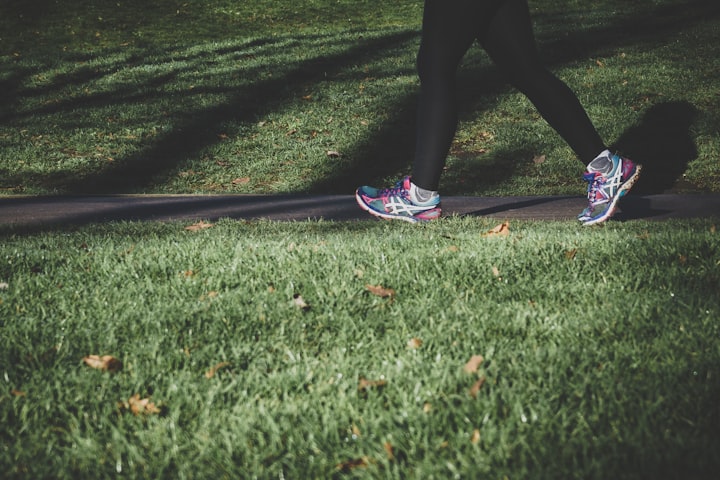Physical activity for health.
Have fun at what you do and do the right thing.

Up to 5 million deaths a year could be averted if the global population was more active. At a time when many people are home bound due to COVID-19, new WHO Guidelines on physical activity and sedentary behaviour, launched today, emphasize that everyone, of all ages and abilities, can be physically active and that every type of movement counts.
The new guidelines recommend at least 150 to 300 minutes of moderate to vigorous aerobic activity per week for all adults, including people living with chronic conditions or disability, and an average of 60 minutes per day for children and adolescents.
WHO statistics show that one in four adults, and four out of five adolescents, do not get enough physical activity. Globally this is estimated to cost US$54 billion in direct health care and another US$14 billion to lost productivity.
The guidelines encourage women to maintain regular physical activity throughout pregnancy and post-delivery. They also highlight the valuable health benefits of physical activity for people living with disabilities.
Older adults (aged 65 years or older) are advised to add activities which emphasize balance and coordination, as well as muscle strengthening, to help prevent falls and improve health.
Regular physical activity is key to preventing and helping to manage heart disease, type-2 diabetes, and cancer, as well as reducing symptoms of depression and anxiety, reducing cognitive decline, improving memory and boosting brain health.
“Being physically active is critical for health and well-being — it can help to add years to life and life to years,” said WHO Director-General Dr Tedros Adhanom Ghebreyesus. “Every move counts, especially now as we manage the constraints of the COVID-19 pandemic. We must all move every day — safely and creatively.”
All physical activity is beneficial and can be done as part of work, sport and leisure or transport (walking, wheeling and cycling), but also through dance, play and everyday household tasks, like gardening and cleaning.
“Physical activity of any type, and any duration can improve health and wellbeing, but more is always better,” said Dr Ruediger Krech, Director of Health Promotion, World Health Organization, “and if you must spend a lot of time sitting still, whether at work or school, you should do more physical activity to counter the harmful effects of sedentary behaviour.”
“These new guidelines highlight how important being active is for our hearts, bodies and minds, and how the favourable outcomes benefit everyone, of all ages and abilities”, said Dr Fiona Bull, Head of the Physical Activity Unit which led the development of the new WHO guidelines.
WHO encourages countries to adopt the global guidelines to develop national health policies in support of the WHO Global action plan on physical activity 2018–2030. The plan was agreed by global health leaders at the 71st World Health Assembly in 2018 to reduce physical inactivity by 15% by 2030.
The new WHO 2020 Guidelines on Physical Activity and Sedentary Behaviour
provide recommendations on the amount and types of physical activity for various age groups, pregnant and post-partum women, and people living with chronic conditions or disabilities. The 2020 WHO guidelines are built on a much larger evidence base than the 2010 guidelines,
and include some major developments. First, evidence for additional health benefits, such as improved cognitive health, health-related quality of life, mental health, and sleep, is reported, over and above what was included in the 2010 WHO guidelines — ie, cancer, cardiorespiratory, metabolic, musculoskeletal, and functional health. This development reflects the maturation of research on physical activity and the growing incorporation of the WHO definition of health as a state of complete physical, mental, and social wellbeing.
Second, the 2020 WHO guidelines, for the first time, on a global level, provide specific recommendations for pregnant and post-partum women and for people living with chronic conditions or disabilities, showing the increasing specificity and relevance of physical activity guidelines to different populations. Third, these guidelines have modified recommendations for how aerobic physical activity should be accumulated — eg, the previous requirement for 10-min minimum duration of continuous activity has been dropped and “some physical activity is better than none”. Finally, the 2020 WHO guidelines provide general recommendations to reduce sitting time, which accords with growing interest in the health effects of sedentary behaviour.
The launch of the 2020 WHO guidelines follows other major physical activity guidelines, most recently in the USA and UK.
These guidelines provide similar recommendations for the types, intensity, volume, and duration of physical activity for both general and specific populations. Meanwhile, the new Canadian 24-Hour Movement Guidelines for Adults,
launched in October, 2020, took a different approach by integrating recommendations for sleep, sedentary behaviour, and physical activity of various intensities. Such a 24-h activity spectrum approach, which aims to account for the interconnections across multiple behaviours, has also been applied in guidelines on physical activity, sedentary behaviour, and sleep for children younger than 5 years by WHO and countries such as Australiaand Canada.
Debate continues about certain aspects of physical activity guideline development. Although some experts consider existing evidence insufficient for supporting quantitative recommendations for sitting time,
others advocate that guidelines should be developed despite insufficient and low-quality evidence.
Furthermore, some researchers propose inclusion of the entire 24-h day in integrated movement guidelines,whereas others raise concerns such as communication challenges and insufficient 24-h compositional evidence. Despite some differences, contemporary physical activity guidelines share many commonalities in their defined public health context, an emphasis on participation, and a socially inclusive approach for reaching the entire population.
Current physical activity guidelines evolved from decades of evidence generation, syntheses, and updates (figure). Early physical activity guidelines focused on continuous vigorous aerobic exercise mainly for performance improvement or cardiac rehabilitation.
With increasing evidence on the health benefits of moderate-intensity physical activity, such as walking, guidelines evolved to become more public health oriented and the focus shifted from exercise, which is planned and structured, to physical activity, which can be part of daily living.
In recent decades, evidence that incorporates device-based measures and sophisticated analytical approaches has further characterised the amount of physical activity associated with health benefits — eg, the curvilinear relationship between physical activity and health outcomes, the value of any duration of physical activity, and the benefits of light-intensity physical activity as a replacement for sedentary time
Such developments have led to the emphasis on doing any physical activity in any duration in the current guidelines. Overall, physical activity guidelines have shifted from exercise training to active living.The new WHO 2020 Guidelines on Physical Activity and Sedentary Behaviour
provide recommendations on the amount and types of physical activity for various age groups, pregnant and post-partum women, and people living with chronic conditions or disabilities. The 2020 WHO guidelines are built on a much larger evidence base than the 2010 guidelines,
and include some major developments. First, evidence for additional health benefits, such as improved cognitive health, health-related quality of life, mental health, and sleep, is reported, over and above what was included in the 2010 WHO guidelines — ie, cancer, cardiorespiratory, metabolic, musculoskeletal, and functional health. This development reflects the maturation of research on physical activity and the growing incorporation of the WHO definition of health as a state of complete physical, mental, and social wellbeing.
Second, the 2020 WHO guidelines, for the first time, on a global level, provide specific recommendations for pregnant and post-partum women and for people living with chronic conditions or disabilities, showing the increasing specificity and relevance of physical activity guidelines to different populations. Third, these guidelines have modified recommendations for how aerobic physical activity should be accumulated — eg, the previous requirement for 10-min minimum duration of continuous activity has been dropped and “some physical activity is better than none”. Finally, the 2020 WHO guidelines provide general recommendations to reduce sitting time, which accords with growing interest in the health effects of sedentary behaviour.
The launch of the 2020 WHO guidelines follows other major physical activity guidelines, most recently in the USA and UK. These guidelines provide similar recommendations for the types, intensity, volume, and duration of physical activity for both general and specific populations. Meanwhile, the new Canadian 24-Hour Movement Guidelines for Adults,
launched in October, 2020, took a different approach by integrating recommendations for sleep, sedentary behaviour, and physical activity of various intensities. Such a 24-h activity spectrum approach, which aims to account for the interconnections across multiple behaviours, has also been applied in guidelines on physical activity, sedentary behaviour, and sleep for children younger than 5 years by WHO and countries such as Australia and Canada. Debate continues about certain aspects of physical activity guideline development. Although some experts consider existing evidence insufficient for supporting quantitative recommendations for sitting time, others advocate that guidelines should be developed despite insufficient and low-quality evidence. Furthermore, some researchers propose inclusion of the entire 24-h day in integrated movement guidelines,
whereas others raise concerns such as communication challenges and insufficient 24-h compositional evidence.
Despite some differences, contemporary physical activity guidelines share many commonalities in their defined public health context, an emphasis on participation, and a socially inclusive approach for reaching the entire population.
Current physical activity guidelines evolved from decades of evidence generation, syntheses, and updates (figure). Early physical activity guidelines focused on continuous vigorous aerobic exercise mainly for performance improvement or cardiac rehabilitation. With increasing evidence on the health benefits of moderate-intensity physical activity, such as walking, guidelines evolved to become more public health oriented and the focus shifted from exercise, which is planned and structured, to physical activity, which can be part of daily living.
In recent decades, evidence that incorporates device-based measures and sophisticated analytical approaches has further characterised the amount of physical activity associated with health benefits — eg, the curvilinear relationship between physical activity and health outcomes, the value of any duration of physical activity, and the benefits of light-intensity physical activity as a replacement for sedentary time.
Such developments have led to the emphasis on doing any physical activity in any duration in the current guidelines.
Overall, physical activity guidelines have shifted from exercise training to active living.
According to Lancet article: Physical activity guidelines 2020: comprehensive and inclusive recommendations to activate populations.
About the Creator
Viona Aminda
Not a fiction story telling






Comments
There are no comments for this story
Be the first to respond and start the conversation.